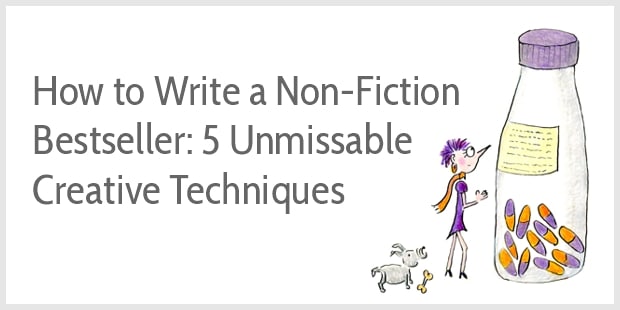 Why do some books make it to the bestseller lists?
Why do some books make it to the bestseller lists?
And others don’t?
It starts of course with a good idea.
Then there’s book marketing.
But how a book is written matters a lot, too.
The smartest non-fiction writers know how to captivate their audience and how to communicate their ideas with power and pizzazz.
They harness 5 powerful creative techniques to write their bestselling books.
Want to know which?
1. Stories in miniature
Stories in non-fiction?
Yes, yes, yes.
Without stories, non-fiction becomes rather dry and dull.
Stories make ideas come alive; they captivate your audience, add drama, and keep people reading; they add sparkle and interest.
And last but not least, research shows that stories provide context and therefore make ideas easier to comprehend and remember.
Adam Grant’s book Hidden Potential showcases how to captivate readers with non-fiction writing. Throughout his book, Grant tells stories to explain and entertain.
For instance, in his chapter on perfectionism, Grant tells the story of award-winning architect Ando to explain that excellence doesn’t equal flawlessness:
When Ando designed his second house, the entire lot was less than 200 square feet. The constraints of the space meant that even if he sought perfection, it would be unattainable.
He had to settle for a design with some fundamental flaws. He built a tiny concrete box without any windows—there was only a skylight at the top.
Stories work best when we take readers by the hand and let them walk with us into our stories. Note how we can imagine standing in that house—a tiny concrete box. We see no windows, until we look up and see the skylight.
A good non-fiction book requires at least one miniature story per chapter. So, look for a stories that help explain your ideas and breathe life into your ideas.
2. A large dollop of substance
A story engages us emotionally and helps us remember.
But we need some substance, too—a connection to the bigger picture. That’s what data and research results are for.
Here’s Adam Grant again:
Extensive evidence shows that it’s having high personal standards, not pursuing perfection, that fuels growth. Many people interpret that as advice to shift from be the best to do your best. But aiming for your best is not the best alternative. Across hundreds of experiments, people who are encouraged to do their best perform worse—and learn less—than those who are randomly assigned to goals that are specific and difficult.
This brief description of the research makes me curious. I would have liked Grant to dwell on the research a bit longer: What drove the researchers? What happened exactly? Behind each piece of research there’s an interesting story, too.
But, of course, these short summaries in Grant’s book work, too. They show us that his ideas are backed up by research.
Remember, stories add emotion; data add substance.
3. A splash of color
The best way to add color?
Use metaphors. They add both power and pizzazz to your writing:
- Power because they help explain abstract ideas more clearly, making them easy to remember.
- Pizzazz because they make your writing more interesting and unique.
Here’s Grant again:
If perfectionism were a medication, the label would alert us to common side effects. Warning: may cause stunted growth.
The power of metaphors lies in the concrete imagery—like the label on a medicine bottle. Abstract ideas are hard to remember but concrete images are sticky.
I love the imagery at the end of the chapter on perfectionism, too:
After the earthquake rocked Kobe, Ando wanted to preserve the artifacts of the past and renew hope for the future. On the waterfront overlooking the mountains, he designed an art museum. The deck features a sculpture of his own: a giant green apple. “In life, it’s better to be green—and the greener the better,” Ando declares. “The green apple is a symbol of youth.”
Ando is now in his eighties, and his youth is reflected in his ongoing desire to grow. Aspiring to stay green is a commitment to continued growth, to staying unfinished. An apple that isn’t ripe is not fully formed—it’s incomplete and imperfect. That’s what makes it beautiful.
In every chapter of his book Hidden Potential, Grant uses metaphors, and it’s fab.
How to dream up metaphors for your book?
First, pick a field you’re interested in, like parenting, sports, cooking, or gardening.
Next, try comparing things at the same level: A process to a process, a thing to a thing, or a role to a role.
Lastly, add sensory details to make the metaphor more vivid—like Grant did with the medicine bottle and the green apple.
Metaphors are the spices of your writing.
4. Your secret sauce
We often see writing as a monologue.
A writer is sharing their thoughts with us, right?
Not quite. Good writing is a conversation, and that requires your presence as a writer. Your stories, experiences, and opinions help you connect with your readers.
Grant writes about dealing with perfectionism in his diving practice:
Eric told me that when announcers rave about dives getting perfect 10s, they’re making a mistake. There’s no such thing as a perfect dive. Even in the Olympic judging rules, a 10 doesn’t stand for perfection—it stands for excellence. He was teaching me the art of wabi sabi.
The lesson hit home: I didn’t need to be perfect. I just needed to aim for a clear, high target.
Eric worked with me to set goals for each dive at the edge of my abilities. On my bread-and-butter basic dive, a front dive pike, we started off aiming for a 6.5. But on my more complicated, shaky flip with a twist, all I needed was a 5.
And if I was learning a new dive, we’d settle for anything above a 0. In other words, not a failure: I’d made the dive.
Readers want to know who they’re having a conversation with, and Grant obliges: He shares his personal stories—not just to connect but also to explain his ideas.
Do you leave a piece of yourself in your writing, too?
5. A final kick
Like the spicy kick of chili peppers, soundbites reinforce key messages, letting them linger in your mind.
Adam Grant is a master of soundbites. For instance, the subheading for the chapter on perfectionism is a great soundbite:
Finding the Sweet Spot between Flawed and Flawless
I like the phrase sweet spot; it’s concrete and sensory and has a positive connotation. It’s where you’d like to be, right? And then the contrast between flawed and flawless adds drama to this subhead.
We usually think of mastery as striving for excellence, if not perfection. But Grant turns this idea on its head:
The more you grow, the better you know which flaws are acceptable.
This soundbite summarizes the story of architect Ando in one memorable line; it’s the essence of how to deal with perfectionism according to Grant.
Can you summarize the key idea of a book chapter in just one memorable line, too?
A recipe for writing a non-fiction book
Writing a book can feel like an impossibly big task.
But you don’t have to do it all in one go.
Get your ideas on paper first, then work on each of the techniques discussed, chapter by chapter.
Add a story. Find some data. Dream up a metaphor. Formulate a sound bite. And leave a piece of you in your writing.
The key to is to keep momentum going.
Do some work daily-ish, and you’ll be surprised how far you’ll get. Paragraph by paragraph, chapter by chapter, your book will sprout, grow, and flower.
Eventually, your book—your baby—will captivate and inspire your readers.
Happy writing!
Recommended reading on writing non-fiction:
How to sell your ideas to skeptics
How to infuse your non-fiction writing with enthusiasm
How a science writer tells gripping adventures


Thanks, Henneke, for putting this together! I love it! My favorite is soundbites. I want to keep learning and growing with regards to developing good soundbites.
The downside is that if you don’t have the right editor, they can remove the spicy kick from of your great soundbites. For my next non-fiction, I’ll be intentional about infusing unforgettable soundbites.
Yes, I find good soundbites fascinating, too. I wrote a little more about how Adam Grant writes soundbites here: https://www.enchantingmarketing.com/parallelism-examples/
Thank you for stopping by, Grace. I appreciate it!
Another inspiring post, Henneke. Thank you.
I’m glad you enjoyed it, Moira. Thank you for stopping by. I appreciate it.
Just reading this post was a joy. I love your writing style. Great, actionable info with a friendly, conversational style… seriously, what’s not to like? It’s also inspiring. I shall be looking for that book. Wow, Henneke…just wow!
Thank you so much for your lovely compliment, Maria. I hope you’ll enjoy Adam Grant’s book, too!
Yet another excellent article!
Thank you, Bruce 🙂
Perfect timing Henneke! I’m picking up the book I began, long overdue. I’ve always recognized the need for fiction techniques in nonfiction, but so seldom find anyone who knows this. Or cares.
Thanks so much for this lovely and much-needed checklist!
Ohhh, so happy my timing was good. I don’t understand why people don’t appreciate that non-fiction is creative, too.
Are you writing a book?
I’ve been writing a book or two for too many years. I was stuck on chapter 4, not because of lack of content, but because it would take the most storytelling of all the chapters, and I really did not know how the main character would have felt. And then we moved house.
So, I spent a few years procrastiwriting at a place that has stopped paying, lately. At least I did build some readership base there.
I’m not stuck, anymore and the last box was unpacked long ago. I think I feel ready to take the main one back up again. It is kind of self-help and I’m glad I did not finish it earlier–I was not ready yet.
But there is more. We help at our local jail and I’ve accumulated a lot of short stories about that time. The Sheriff thinks I should put those in a book, too. Nonfiction, but fiction techniques needed, please! 🙂
It makes me happy to read that you ready to dive into your book writing again. These sound like great projects.
I’m cheering you on! 🖤
Thank you, Henneke – this is incredibly useful (and expressed with your usual flair and grace!). I’ve been asked to be a beta reader for a non-fiction manuscript and am having a preliminary chat with the author tomorrow. If he and I decide to go ahead, I’ll be sure to include your five points in my feedback. Your timing is perfect!
Ohhh, that sounds good. I’m glad this arrived just in time. I hope you’ll have a fruitful discussion about the manuscript!
Practice makes progress
Progress is growth along your path
Enjoy the journey more
Than the end result
The journey is all that endures
D. W. Morris
7-8-25
Ohhh, Dennis, I’ve missed you recently! Thank you for being here again. I love your focus on the journey and growth. 🖤
This post is splendiferous. So much wisdom here. We do tend to look at things in large chunks, don’t we? The magic is in breaking things down into bite-sized bits of brilliance crafted with precision and pizazz.
Yes, we tend to read to understand the ideas but then overlook how those ideas are actually communicated. Grant’s book is so interesting to study because he uses these techniques so consistently. Thank you for stopping by, Karen. I appreciate it.
wow
What made you comment wow?
Usually, I don’t allow one-word comments but I’m curious!
It is a complete recipe in one place for creative nonfiction.
Yes, it is! I’ve not seen anyone share it like this. Thank you for clarifying. I appreciate it. Happy writing!